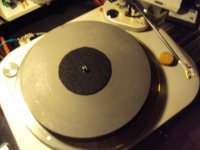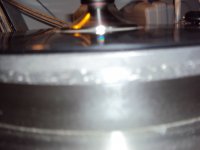Maybe using a slow motor with a larger drive pulley would reduce the "jump".I know that the belt should be really without any mechanical defects, like the one i have shown in post 157. Where the opposites meet it will never be totally perfect.
I can measure this with Dr.Feikert Adjust+ on my SG1 as a slight speed "jump" when the seam rolls over the pulley, even with the high mass, flywheel platter of the SG1.
A cast ( one piece ) belt did not show this defect but where to get one ?
I think Adjust + is good.
It needs a bit of experience to use and Chris Feikert knows much more about the details then me.
By the way, he is quite disappointed how few he could sell.
Old, story. Hearsay is more important in Audio then "cold" measurements.
He even ran into trouble with some manufacturers because he could show them some defects they did not like to see.
It needs a bit of experience to use and Chris Feikert knows much more about the details then me.
By the way, he is quite disappointed how few he could sell.
Old, story. Hearsay is more important in Audio then "cold" measurements.
He even ran into trouble with some manufacturers because he could show them some defects they did not like to see.
Joachim,
why would you use such a small diameter pad to lift the vinyl? It appears from just the photo that the vinyl would be hanging in the air except for the center section, am I seeing that correctly? I would think you would still want to support the vinyl all the way to the edges and not just the center section as I could imagine that there would be some movement vertically with that implementation if I am seeing what I think I see?
why would you use such a small diameter pad to lift the vinyl? It appears from just the photo that the vinyl would be hanging in the air except for the center section, am I seeing that correctly? I would think you would still want to support the vinyl all the way to the edges and not just the center section as I could imagine that there would be some movement vertically with that implementation if I am seeing what I think I see?
Joachim,
why would you use such a small diameter pad to lift the vinyl? It appears from just the photo that the vinyl would be hanging in the air except for the center section, am I seeing that correctly? I would think you would still want to support the vinyl all the way to the edges and not just the center section as I could imagine that there would be some movement vertically with that implementation if I am seeing what I think I see?
1-2 mm thickness ,not diameter.
Miklos,
I am not going by his 1 or 2mm thickness but looking at the outside diameter of the platter and the small diameter of the pad from the photo. It looks like it is less than 1/2 of the diameter of the platter and that was throwing me off. Unless of course he was listening to a 45rpm single that looks very small in diameter to me. That was what makes me think that most of the vinyl was hanging in the air except for the center section?
I am not going by his 1 or 2mm thickness but looking at the outside diameter of the platter and the small diameter of the pad from the photo. It looks like it is less than 1/2 of the diameter of the platter and that was throwing me off. Unless of course he was listening to a 45rpm single that looks very small in diameter to me. That was what makes me think that most of the vinyl was hanging in the air except for the center section?
1-2 mm thickness ,not diameter.
...but, if the felt is compressed in the middle by the clamp down weight, that could make the record bend concave and the edge lift up and end up being sort of unsupported in the air. What was the reason for the experiment?
Miklos,
I am not going by his 1 or 2mm thickness but looking at the outside diameter of the platter and the small diameter of the pad from the photo. It looks like it is less than 1/2 of the diameter of the platter and that was throwing me off. Unless of course he was listening to a 45rpm single that looks very small in diameter to me. That was what makes me think that most of the vinyl was hanging in the air except for the center section?
Sorry, I didn't noticed the diameter difference, I looked the pics on a telephone. I believed the felt is also 30cm in diameter.😱
Last edited:
If you look back in this tread you see the reason for this experiment.
The main reason i am trying this is to find a way to decouple the record from the brass platter.
Yes, it lifts off most of the record and when the record is not flat the needle will bounce up and down.
Nevertheless, with flat records, i got an interesting change in sound.
Especially noise from scratches and dirt was reduced and it sounded slightly sweeter.
On my table i am now back to conventional because i had to lift the arm so high for VTA compensation that the lift did not work any more. To put the needle in the grove by hand was ultimately too inconvenient.
The main reason i am trying this is to find a way to decouple the record from the brass platter.
Yes, it lifts off most of the record and when the record is not flat the needle will bounce up and down.
Nevertheless, with flat records, i got an interesting change in sound.
Especially noise from scratches and dirt was reduced and it sounded slightly sweeter.
On my table i am now back to conventional because i had to lift the arm so high for VTA compensation that the lift did not work any more. To put the needle in the grove by hand was ultimately too inconvenient.
Many years ago I heard the results of similar trials by Be Yamamura. The results were very similar to those described by Joachim. In a commercial TT Be Yamamura carried forward the concept of minimal support for the disc as seen in this pic.
Attachments
If you look back in this tread you see the reason for this experiment.
The main reason i am trying this is to find a way to decouple the record from the brass platter.
Yes, it lifts off most of the record and when the record is not flat the needle will bounce up and down.
Nevertheless, with flat records, i got an interesting change in sound.
Especially noise from scratches and dirt was reduced and it sounded slightly sweeter.
On my table i am now back to conventional because i had to lift the arm so high for VTA compensation that the lift did not work any more. To put the needle in the grove by hand was ultimately too inconvenient.
Thanks. I thought that leaving the records unsupported vertically would make it prone to vibrations, which would alter the sound. Which you confirmed. One would think at duplicating part of the cutting conditions in playback ,like arm and stylus etc. would be the desirable way to play a record.
Why not do what Goldmund, Kuzma, etc. Do with their big platters and sandwhich some acrylic too both sides of platter to quench the ring that would come through and make at least a screw down record clamp ala Oracle style to couple it all together?
I use both a vaccuum system (Sota) and the Oracle way on my Diy table and would never go back to the considerable amount of warped records out there that take away what we want out of the LP experience.
I get it that you want to decouple it from the platter and this alone places extreme demands on what ever method you do to achieve tight coupling, but its doable. The VPI perimeter ring is another idea worth considering
I just picked up a Spectral MCR reference and know this low compliance MC would not like a loose foundation under it.
I say make your record a 15 pound one and let the stylus see no other way out.
I use both a vaccuum system (Sota) and the Oracle way on my Diy table and would never go back to the considerable amount of warped records out there that take away what we want out of the LP experience.
I get it that you want to decouple it from the platter and this alone places extreme demands on what ever method you do to achieve tight coupling, but its doable. The VPI perimeter ring is another idea worth considering
I just picked up a Spectral MCR reference and know this low compliance MC would not like a loose foundation under it.
I say make your record a 15 pound one and let the stylus see no other way out.
Sure, i am a fan of clamping the record too.
I have also shown another option where the record is on a plastic mat that is decouples from the platter with gel pads.
Anyway, we are in the brainstorming phase still and what sounds and works best has still to be determined.
I have also shown another option where the record is on a plastic mat that is decouples from the platter with gel pads.
Anyway, we are in the brainstorming phase still and what sounds and works best has still to be determined.
Just an off the cuff thought here would be to use a TPE-PU material at about 1 or 2mm thickness in extruded form would decouple the vinyl from the platter and still allow for a thin section, high damping and the ability to clamp the vinyl without a problem of compression of the mat. This would be the same material that I am using to make surrounds for loudspeakers, the best of most things without having to introduce other problems.
The idea of cork sounds fine, I would only worry that over time the cork would be damaged with small grains being lost over time. Cheap enough to replace when it was damaged, but I am not sure about the compression set that may happen over time if the vinyl was clamped down?
The idea of cork sounds fine, I would only worry that over time the cork would be damaged with small grains being lost over time. Cheap enough to replace when it was damaged, but I am not sure about the compression set that may happen over time if the vinyl was clamped down?
how would you treat the graphite.
or is there somthing im missing? we use graphite molds at work and you get it all over your hands like from a #2 pencil.
wouldnt that get on/in the record?
or is there somthing im missing? we use graphite molds at work and you get it all over your hands like from a #2 pencil.
wouldnt that get on/in the record?
The Spiral Groove SG 1 i use has graphite as the material on top.
I think it is treated with oil.
One good thing about it is that it conducts electricity so there is not much static charge.
I think it is treated with oil.
One good thing about it is that it conducts electricity so there is not much static charge.
- Status
- Not open for further replies.
- Home
- Source & Line
- Analogue Source
- The Good Turntable


